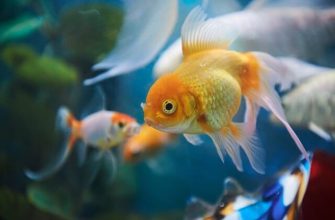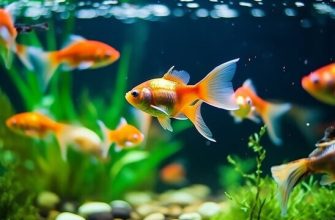Goldfish (Carassius auratus) have a long history of domestication, originating from Prussian carp in ancient China over a thousand years ago. They were selectively bred for their beautiful color variations and body types, becoming popular pets and symbols of good fortune.
Today, goldfish are one of the most commonly kept aquarium fish. They are social fish that prefer to live in groups. The minimum recommended tank size for fancy goldfish is 20 gallons for the first fish and 10 additional gallons per extra fish. Single-tail goldfish need even more room. Goldfish eat a variety of foods including flakes, pellets, frozen and freeze-dried treats. They thrive in cool water between 65-75°F. With proper care, goldfish can live 10 years or longer.
Ideal Tank Conditions

Goldfish require large tanks with strong filtration to thrive. The general recommendation is 20-30 gallons for the first fancy goldfish, plus an additional 10-20 gallons per additional goldfish. This allows adequate swimming space and dilutes waste. Goldfish are messy fish that produce a lot of ammonia, so filtration should be robust. Canister filters or multiple hang-on-back filters are recommended to provide sufficient biological, mechanical, and chemical filtration.
In terms of water parameters, goldfish do best in slightly alkaline conditions between 7.0-8.0 pH. They prefer moderately hard water with a carbonate hardness around 5-12 dKH. Regular partial water changes will help maintain clean, fresh water. Goldfish are tolerant of varied conditions, but aim to keep ammonia and nitrites at 0 ppm and nitrates under 40 ppm.
Suitable Tankmates
Some fish make good tankmates for goldfish as they have similar needs for water temperature, pH, space, and diet. Minnows like white cloud mountain minnows and paradise fish do well with goldfish. Small tetras like neon tetras and cardinal tetras are also suitable, staying out of the way of slow-moving fancy goldfish.
Bottom dwellers like corydoras catfish and bristlenose plecostomus work with goldfish too. Cory cats eat leftover food that sinks and help keep the tank clean, while plecos munch on algae. Both species tolerate similar water parameters as goldfish. Smaller catfish like otocinclus can work if the goldfish are not too large and aggressive. In general, bottom feeders that are peaceful do well with goldfish.
Fish to Avoid

Goldfish are generally peaceful fish, but there are some types that should be avoided as tankmates due to aggression, nippy behavior, or compatibility issues.
Cichlids and oscars can be too aggressive, and may nip at goldfish or compete for food. Their territorial nature is not ideal for goldfish. Slow moving fish like fancy guppies are also not recommended, as goldfish could easily eat them.
Other fish to avoid include:
- Tiger barbs – very nippy and may fin nip goldfish
- Tetras like neon and cardinal tetras – too small, could be eaten
- Bettas – may be nippy toward goldfish
- Gouramis – can be aggressive
In general, avoid any aggressive fish that could harm goldfish, and small fish that could be eaten. Stick to similar sized peaceful community fish for goldfish tankmates.
Invertebrate Options
When choosing invertebrates to add to a goldfish tank, certain options tend to be safer than others. Snails and shrimp can make good tankmates if selected carefully.
Ramshorn and nerite snails are usually safe options, as their shells offer protection from goldfish. Make sure to avoid Malaysian Trumpet snails, as goldfish may consume them. Shrimp like Amano, Ghost, and Cherry can work but may get eaten, especially when molting.
It’s best to avoid crabs and crayfish in a goldfish tank, as they may nip fins or compete for food. Crayfish in particular can grow large enough to attack goldfish. Overall, snails and shrimp offer the lowest risk companions for goldfish when chosen appropriately. Start with just a few, monitor any aggression, and offer plenty of hiding spots.
Plant Considerations
Goldfish love to nibble on plants, so it’s important to choose hardy options that can withstand their appetite. Some good options include Anubias and Java Fern. These plants have tough leaves that goldfish tend to avoid. You can attach them to driftwood or rocks rather than planting them in the substrate, as goldfish may uproot more delicate plants.
Avoid delicate, soft-leaved plants like cabomba, as goldfish will likely munch on them. Floating plants like duckweed can also work well, providing shade and helping absorb excess nutrients from the water. Just be prepared for your goldfish to nibble on these as well. The key is providing plants that can withstand the goldfish’s appetite for greenery and their tendency to dig around. Hardy plants will regrow even after being nibbled on. With the right choices, you can have a planted goldfish tank. Just stick to tough plants they are less likely to demolish.
Tank Setup Tips
Goldfish thrive in tanks with plenty of hiding spaces and areas to explore. Sand or fine gravel substrates 1-2 inches deep allow goldfish to sift and search for food. Decorations like rocks, driftwood, and artificial plants provide enrichment, but make sure decor has no sharp edges or small parts that could injure goldfish. Live plants like Anubias and Java Fern are goldfish-safe choices that also help filter the water.
Avoid plastic plants and sharp gravel that could damage fins and scales. Give goldfish room to swim with open areas of tank. Undergravel filters allow goldfish to sift substrate without getting stuck. Power filters should have low flow to avoid pushing around weaker swimmers. Perform weekly 25% water changes and siphon waste from substrate to keep water clean.
Water Changes

Goldfish are sensitive to water quality, so regular water changes are critical for their health and longevity. The general recommendation is to change 25-50% of the water weekly. The exact frequency and amount will depend on factors like tank size, stocking levels, and filtration.
When performing water changes, use a gravel vacuum to remove debris from the substrate. Replace the removed water with dechlorinated tap water that’s the same temperature as the tank. Use a good water conditioner to remove chlorine and heavy metals. Many keepers recommend Seachem Prime as an effective conditioner for goldfish tanks. The new water should be tested to confirm the parameters match the tank water.
Partial water changes help reset nitrate levels, replenish minerals, and remove harmful hormones and waste. This keeps water parameters stable and prevents ammonia spikes. Consistent water changes are key for healthy goldfish and reducing disease risks.
Signs of Stress
It’s important to monitor your goldfish for signs of stress, as this can indicate compatibility issues with tankmates. Some common signs of stress in goldfish include hiding or staying at the bottom of the tank, loss of coloration or faded coloring, rapid gill movement, clamped fins, lack of appetite, and erratic swimming. If introduced tankmates are harassing, nipping, or chasing your goldfish, this harassment will cause severe distress.
Goldfish that are stressed by incompatible tankmates may stop eating, hide constantly, or even display neurotic behaviors like rubbing against objects or darting around the tank. If your goldfish exhibits any of these warning signs, closely observe all fish relationships in the tank and be prepared to remove aggressors. Stressed goldfish are vulnerable to disease, so addressing compatibility issues quickly is crucial.
Success Stories
Many aquarists have had success creating compatible goldfish communities.
Here are some examples:
- This Reddit user set up a 55 gallon tank with 3 fancy goldfish and 5 cory catfish. The corys were added several months after the goldfish and have thrived together for over a year. The key was choosing cory species that prefer similar water conditions to goldfish.
- Another hobbyist shares how they combined 3 fancy goldfish, 5 white cloud minnows, and 4 nerite snails in a 40 gallon breeder tank. The minnows swim in the upper water column while the goldfish stay lower. The nerites help clean algae.
Providing plenty of swimming space, hiding spots, and clean water are critical for long-term success. Tankmates should be added gradually and monitored. Overall, patience and research is required to find suitable companions for goldfish. But many enthusiasts have proven it can work wonderfully.








